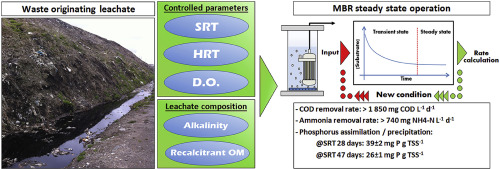当前位置:
X-MOL 学术
›
J. Environ. Manag.
›
论文详情
Our official English website, www.x-mol.net, welcomes your
feedback! (Note: you will need to create a separate account there.)
MBR treatment of leachates originating from waste management facilities: A reference study of the design parameters for efficient treatment.
Journal of Environmental Management ( IF 8.0 ) Pub Date : 2020-01-09 , DOI: 10.1016/j.jenvman.2019.110057 Dany Roy 1 , Patrick Drogui 1 , Rajeshwar D Tyagi 1 , Dany Landry 2 , Mohamed Rahni 3
Journal of Environmental Management ( IF 8.0 ) Pub Date : 2020-01-09 , DOI: 10.1016/j.jenvman.2019.110057 Dany Roy 1 , Patrick Drogui 1 , Rajeshwar D Tyagi 1 , Dany Landry 2 , Mohamed Rahni 3
Affiliation

|
The main objective of the study was to define the interaction between the solid retention time (SRT) and the contaminant loading rate on a membrane bioreactor's efficacy in removing contaminants frequently detected (chemical oxygen demand (COD), NH4+, total phosphorus and metals) above the discharge criteria in waste-originating leachates. The rates and coefficient calculated from this study's experimental data can be used for the design of membrane bioreactor treating wastewaters, even beyond the scope of this experiment. Over a period of 152 days, SRTs of 28 and 47 days and HRTs of 13, 25, 36 and 52 h were studied using a real leachate with a constant composition. Results showed that membrane bioreactors can efficiently treat >1850 mg COD L-1 d-1 of highly to moderately biodegradable COD, with the SRT having no significant impact on the removal of recalcitrant COD. Overall ammonium removal rates of >740 mg NH4-N L-1 d-1 can be achieved as long as a residual alkalinity of 200 mg CaCO3 L-1 and an adequate dissolved oxygen concentration (6-7 mg L-1) are both maintained. Overall phosphorus removal rates are independent of the phosphorus loading rate. However, the highest overall phosphorus removal rate (39 ± 2 mg P per g of total suspended solids) was obtained at the lowest SRT (28 days) due to an increased extracellular polymeric substance production. Finally, membrane bioreactor's metal removal capacity is mostly dependent on the metals' affinity to both the leachate's recalcitrant COD as well as sludge concentrations.
中文翻译:

MBR处理源自废物管理设施的渗滤液:有效处理设计参数的参考研究。
这项研究的主要目的是确定固体保留时间(SRT)和污染物装载速率之间的相互作用,以提高膜生物反应器去除上述经常检测到的污染物(化学需氧量(COD),NH4 +,总磷和金属)的功效。源自废物的渗滤液的排放标准。从这项研究的实验数据计算出的比率和系数可用于膜生物反应器处理废水的设计,甚至超出了本实验的范围。在152天的时间内,使用具有恒定组成的实际渗滤液研究了28天和47天的SRT和13、25、36和52 h的HRT。结果表明,膜生物反应器可以有效处理> 1850 mg COD L-1 d-1的高至中度可生物降解的COD,SRT对顽固化学需氧量的去除没有显着影响。只要残留碱度为200 mg CaCO3 L-1和足够的溶解氧浓度(6-7 mg L-1)都可以实现> 740 mg NH4-N L-1 d-1的总铵去除率保持。总磷去除率与磷负载率无关。但是,由于增加了细胞外聚合物质的产生,因此在最低的SRT(28天)下获得了最高的总磷去除率(每克总悬浮固体39±2 mg P)。最后,膜生物反应器的金属去除能力主要取决于金属对渗滤液难降解化学需氧量以及污泥浓度的亲和力。只要保持200 mg CaCO3 L-1的残留碱度和足够的溶解氧浓度(6-7 mg L-1),就可以达到740 mg NH4-N L-1 d-1。总磷去除率与磷负载率无关。但是,由于增加了细胞外聚合物质的产生,因此在最低的SRT(28天)下获得了最高的总磷去除率(每克总悬浮固体39±2 mg P)。最后,膜生物反应器的金属去除能力主要取决于金属对渗滤液难降解化学需氧量以及污泥浓度的亲和力。只要保持200 mg CaCO3 L-1的残留碱度和足够的溶解氧浓度(6-7 mg L-1),就可以达到740 mg NH4-N L-1 d-1。总磷去除率与磷负载率无关。但是,由于增加了细胞外聚合物质的产生,因此在最低的SRT(28天)下获得了最高的总磷去除率(每克总悬浮固体39±2 mg P)。最后,膜生物反应器的金属去除能力主要取决于金属对渗滤液难降解化学需氧量以及污泥浓度的亲和力。但是,由于增加了细胞外聚合物质的产生,因此在最低的SRT(28天)下获得了最高的总磷去除率(每克总悬浮固体39±2 mg P)。最后,膜生物反应器的金属去除能力主要取决于金属对渗滤液难降解化学需氧量以及污泥浓度的亲和力。但是,由于增加了细胞外聚合物质的产生,因此在最低的SRT(28天)下获得了最高的总磷去除率(每克总悬浮固体39±2 mg P)。最后,膜生物反应器的金属去除能力主要取决于金属对渗滤液难降解化学需氧量以及污泥浓度的亲和力。
更新日期:2020-01-09
中文翻译:

MBR处理源自废物管理设施的渗滤液:有效处理设计参数的参考研究。
这项研究的主要目的是确定固体保留时间(SRT)和污染物装载速率之间的相互作用,以提高膜生物反应器去除上述经常检测到的污染物(化学需氧量(COD),NH4 +,总磷和金属)的功效。源自废物的渗滤液的排放标准。从这项研究的实验数据计算出的比率和系数可用于膜生物反应器处理废水的设计,甚至超出了本实验的范围。在152天的时间内,使用具有恒定组成的实际渗滤液研究了28天和47天的SRT和13、25、36和52 h的HRT。结果表明,膜生物反应器可以有效处理> 1850 mg COD L-1 d-1的高至中度可生物降解的COD,SRT对顽固化学需氧量的去除没有显着影响。只要残留碱度为200 mg CaCO3 L-1和足够的溶解氧浓度(6-7 mg L-1)都可以实现> 740 mg NH4-N L-1 d-1的总铵去除率保持。总磷去除率与磷负载率无关。但是,由于增加了细胞外聚合物质的产生,因此在最低的SRT(28天)下获得了最高的总磷去除率(每克总悬浮固体39±2 mg P)。最后,膜生物反应器的金属去除能力主要取决于金属对渗滤液难降解化学需氧量以及污泥浓度的亲和力。只要保持200 mg CaCO3 L-1的残留碱度和足够的溶解氧浓度(6-7 mg L-1),就可以达到740 mg NH4-N L-1 d-1。总磷去除率与磷负载率无关。但是,由于增加了细胞外聚合物质的产生,因此在最低的SRT(28天)下获得了最高的总磷去除率(每克总悬浮固体39±2 mg P)。最后,膜生物反应器的金属去除能力主要取决于金属对渗滤液难降解化学需氧量以及污泥浓度的亲和力。只要保持200 mg CaCO3 L-1的残留碱度和足够的溶解氧浓度(6-7 mg L-1),就可以达到740 mg NH4-N L-1 d-1。总磷去除率与磷负载率无关。但是,由于增加了细胞外聚合物质的产生,因此在最低的SRT(28天)下获得了最高的总磷去除率(每克总悬浮固体39±2 mg P)。最后,膜生物反应器的金属去除能力主要取决于金属对渗滤液难降解化学需氧量以及污泥浓度的亲和力。但是,由于增加了细胞外聚合物质的产生,因此在最低的SRT(28天)下获得了最高的总磷去除率(每克总悬浮固体39±2 mg P)。最后,膜生物反应器的金属去除能力主要取决于金属对渗滤液难降解化学需氧量以及污泥浓度的亲和力。但是,由于增加了细胞外聚合物质的产生,因此在最低的SRT(28天)下获得了最高的总磷去除率(每克总悬浮固体39±2 mg P)。最后,膜生物反应器的金属去除能力主要取决于金属对渗滤液难降解化学需氧量以及污泥浓度的亲和力。











































 京公网安备 11010802027423号
京公网安备 11010802027423号